We bought our Victorian just in time to experience the coldest winter here on record in Chicago. A pipe even burst in the basement! (Although to be fair, that happened to a lot of homes in the area. A pipe burst in our old house too, with which we had never experienced any heating problems.) After sealing our drafty windows with plastic sheeting the house stayed dramatically warmer, and we also had our old boiler serviced and bled the radiators. The house still struggled to stay in the mid to high 60s on the first floor though, while it was comfortably warm upstairs and hot all the way up on the third floor. So before another winter comes, we had some work done to the house’s heating system.
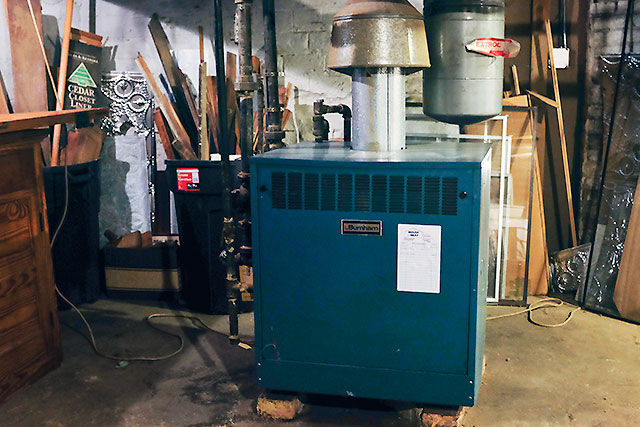
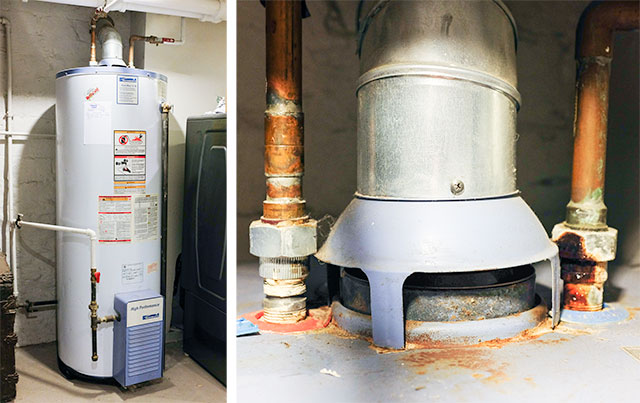
The boiler still has some life left in it, but its chimney is in need of big repairs. We could have added a liner to prevent further corrosion, but the age and condition of the brick would have made it an expensive and difficult job. Another option for roughly the same cost was to replace the old boiler with a new model that was more energy-efficient and that could be vented out the side of the house, so that’s what we chose to do. We also replaced the water heater at the same time. There was a backdrafting issue identified during our house inspection, there wasn’t enough capacity for a house of this size, and the thing also had to be fixed twice in the last two months. Those three factors swayed us toward replacement. We chose an indirect water heater which is now tied into our new boiler, so it’s piggybacking off of the radiator system for faster heating and more efficiency.
Ooh, get ready for some more Pinterest-worthy pictures!
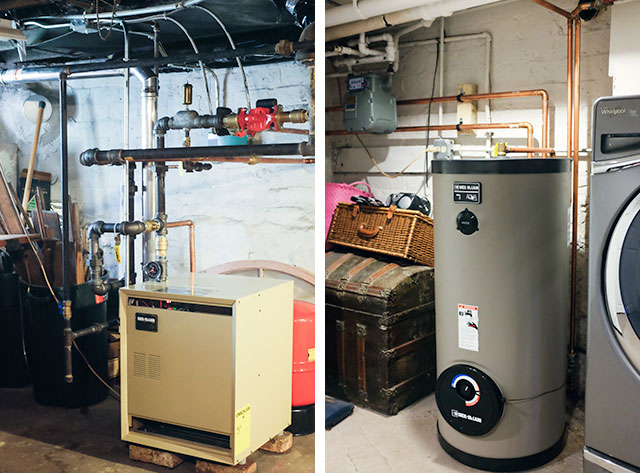
So pretty, right? Our basement’s a gem.
And we’re down to a single gas meter! The Victorian was split into apartments in the 1930s (common in the depression era), and it was still a multi-family house until just before being sold. There remained both a residential and commercial account for gas, and getting them combined into one residential account (which has significantly lower rates) was a long process. Lots of red tape and hoops to jump through, and the expense of rerouting the pipes is the responsibility of the home owner. We started the process right away when we moved in a year ago, and it took a good ten months.
Then there’s the last of our heating system upgrades. We were cautioned against using the valves on our radiators because when they’re as old as ours, mineral build-up and corrosion can cause them to break with use. Hot water radiators are either on or off — there’s no middle adjustment — so ours were all on, all winter. That third floor was toasty. Now we’ve added thermostatic radiator valves to each of the six radiators on the third floor, and to two of them on the second floor (in rooms that were consistently warmer than the rest). They aren’t pretty, but they’ll automatically turn the radiators off when the room temperature is warm enough, so that the heat can be directed to where it’s needed instead. The valves are currently set at 68, but we’ll experiment to see what’s best when winter comes — they can all be individually adjusted.
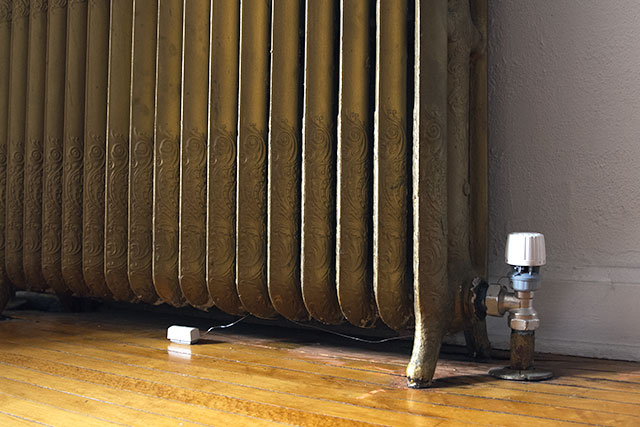
Brandon and I can take consecutive showers now without running out of hot water, and between the new valves and the boiler, we should see more even and efficient heating this winter. That, and the elimination of the commercial account, will also bring lower heating bills. Working on the guts of the house doesn’t bring the prettiest pictures, but we’re glad to have had the work done.



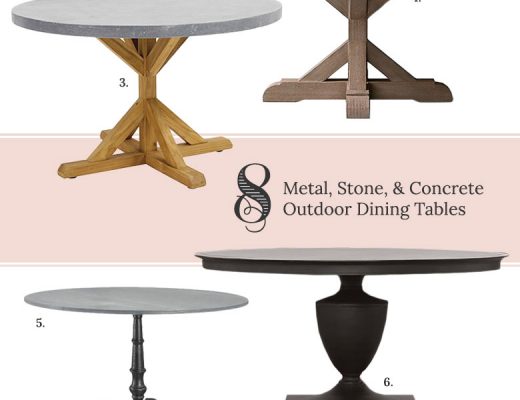


Caroline
August 27, 2014 at 10:53 amSo glad you and the children will be warmer this winter! My daughter and her family live in Chicago, too, so I know about those brutal winters! I have 2 different questions-
All that unused, hot rising air on the third floor, seems to be hugely energy inefficient. Is there some way to bring that hot air, on the 3 rd floor, down to the lower floors? Seems like such a waste of much needed warm air. It would bring down the temp of the play room, too, so the kids would be more comfortable.
My other question is- I spot 2 amazing things in your basement! That wonderful wicker picnic? basket and the amazing old trunk. It seems like storing them in a damp basement, right next to the water heater (nearly against it), is not the greatest place to keep them. Plus can’t you use them upstairs? They are fantastic!
Thanks Nicole!
Making it Lovely
August 27, 2014 at 11:04 amI suspect we can turn the radiator valves down even further, and rely more heavily on warm air rising to heat the third floor. The 68 degree setting is a starting point, and we’ll adjust as needed.
We don’t really have a spot for the picnic basket or trunk upstairs, but thankfully our basement stays nice and dry. And that trunk is one of two that were left behind by the previous owners, along with a giant old safe! You can see them here.
Alison
August 27, 2014 at 10:58 amGreat! We are in a bungalow with hot water heat, and will be renovating the upstairs very soon. We have to remove the current chimney to make way for new stairs, so we will be going with high efficiency boiler also, vented out the side of the house.
Make sure to check for rebates with your upgrades, I know Peoples Gas offers some nice ones currently (we’re in the city) not sure about the suburbs gas companies.
Making it Lovely
August 28, 2014 at 11:25 amNicor does offer some rebates as well — thanks for the reminder!
Carol
August 27, 2014 at 11:18 amAs a fellow Oak Parker, I’m curious to find out who you used to do the work.
Making it Lovely
August 27, 2014 at 11:20 amWe used House of Heat. We always hired them to do heating and cooling work in our first house too.
Carol
August 28, 2014 at 9:09 amThanks, Nicole. We’ve used them in the past too.
Julie
August 27, 2014 at 11:32 amI love these kinds of posts! Super interesting! I love seeing how various old home issues are resolved or worked around with modern fixes…
Richelle
August 27, 2014 at 11:50 amGlad to know we’re not the only ones doing this super-sexy type of work on their house. :)
I hadn’t heard about the thermostatic valves – will have to research that further to see if it will be useful at our place. Thanks for posting this!
Making it Lovely
August 28, 2014 at 11:26 amIt is the sexiest of home-related work. ;)
Celeste
August 27, 2014 at 11:51 amThough the post might not bring the most Pinterest-worthy photos, these “guts of the house” posts are some of my favorites. I want to buy an older house and remodel one day (my dad is a contractor and has urged me to go in considering redoing electrical and plumbing) so learning what you have had to do and the issues you’ve had to address is so, so helpful! Love that you’re not just showing the design angle and the pretty pictures, but the educational and practical aspects as well.
Meg@sparrowhaunt.com
August 27, 2014 at 12:34 pmAs someone with a similarly sized house with similar heating challenges I’d love to know what brand you chose, as well as pricing if you don’t mind sharing. Hopefully we can keep our system limping along for a few more years though….
Making it Lovely
August 28, 2014 at 11:51 amWe went with the brand that House of Heat (a local company we’ve worked with for years, starting in the first house) suggested, which was Weil-McLain. I don’t have the itemized pricing handy, but it was several thousand dollars.
Amy
August 27, 2014 at 1:02 pmAh. Good call. I always hate to think of spending money on this kind of thing but it’s so necessary and makes you so much more comfortable. Our house has an electric forced air furnace and I just never feel warm – especially after growing up with a wood stove! I’m sure you’ll be so happy when it’s cold out!
Alison
August 27, 2014 at 1:07 pmAs someone who’s always had a furnace, I’m kind of lost on the boiler discussion… somehow when I hear “boiler” I think of oil heat. But it sounds like your boiler uses natural gas? Was it converted at some point in the home’s history?
Also, just out of curiosity, do people in your neighborhood with gas heat ever switch over to forced air/furnace systems, or do they tend to stick with boilers and radiators? I’m guessing that this would only be possible in the context of a big remodel so that all the duct work could get installed.
Danielle
August 27, 2014 at 1:58 pmMy home is almost 70 years old with a boiler. It would cost a lot to convert to forced air because duct work would need to be done. So we stuck with the boiler, which we don’t mind. Ours uses natural gas.
Making it Lovely
August 28, 2014 at 11:54 amOur boiler uses natural gas, and has for at least 50 years. The house probably burned coal before that, and there’s evidence that it may have had a gravity octopus furnace at one point.
Janine
August 27, 2014 at 1:51 pmI’m loyal! I’m going to pinterest these pictures. Quality HVAC is stylish!
Making it Lovely
August 28, 2014 at 11:59 am:)
Kate
August 27, 2014 at 2:39 pmI would also look at the insulation in your home. We have a 1890 home and an old boiler and have looked at replacement. The home is so leaky that we will save more by sealing the leaks and adding insulation first. Be sure to check your basement for leaks, especially around windows or coal chutes. An audit told us that our basement was just as bad as our third floor!
Jess
August 27, 2014 at 3:55 pmI love these types of practical posts!
judy
August 27, 2014 at 5:39 pmWe recently had to replace our HVAC system, the latest repair was a”squirrel cage?” that would have been 3 or 4 hundred dollars except we had a particular heat pump that needed its own version and therefore the cost was going to be over a thousand dollars. the system was 16 yrs. old, the end of suggested longevity so we went with Costco’s program. It was more expensive but we have had total satisfaction with their return policy and figured they would only use good systems and dependable installers. The added dividend we got with this was access to the other side of our Attic and much needed storage. I had talked to other installers and they had quoted $2500.00 to lift the duct work from 2 ft. off of the floor(requiring we 70 years plus owners to crawl to that side) to a height we could walk under. The Costco salesman said no until I said goodbye and then he said yes-can do. Funny how that works! So goodbye $11,000.00 dollars Hello new system. Works great and the Electric bill has dropped significantly. We have now invested $30,000.00 dollars in a home that has dropped $30,000.00 dollars in value so other than that things are warm, cool and wonderful.
Xenia
August 28, 2014 at 4:34 amThis is a very informative post, and much needed since this Labor Day weekend marks the unofficial end of summer.
Jennifer R.
August 28, 2014 at 8:44 amWow, that’s a lot of upgrades. Funny how things like this that are much less fun to spend money on actually add a lot of function and value to your home.
Would you mind sharing how much your utilities run? I just imagine it to be expensive to heat/cool/light such a large older home.
Making it Lovely
August 28, 2014 at 12:07 pmIt wouldn’t be a direct comparison for utility rates on gas, because we’ve been paying commercial rates until the past couple of months. Our highest electric bill was $80 for the month — the house has stayed relatively cool, naturally, so we’ve only used our window A/C units sparingly. (Thank you, high ceilings, transom windows, and mild summer!)
Heidi S.
August 28, 2014 at 9:52 amThanks for this post! There is a lot of unsexy stuff in keeping up an old house, but these kind of upgrades actually make a huge difference.
I wish we had gone with a more efficient boiler when we replaced ours (8 years ago). Unfortunately we had a condemned oil tank in late September and ended up having to make the change from oil to gas and install a new boiler in a very quick period. In the end it would have been cheaper to go with a more efficient boiler since we ended up having to do extensive chimney work to a 45′ high chimney (which was $$$).
http://www.statelykitsch.com/the-chimney-update-day-2/
I didn’t know about the thermostatic radiator valves. I will have to look into getting a couple of those! We insulated the 3rd floor ceiling/ roof with spray foam a couple of years ago and now we have a problem with the upper floors being too warm. These should definitely help.
Making it Lovely
August 28, 2014 at 12:09 pmOur chimney needs a lot of work, too, but at least now we can just focus on making it structurally sound instead of also protecting against condensation and corrosion from the boiler’s venting. And yes, look into the TRVs! You can add them at any time to an existing radiator system.
AshleyHami
August 28, 2014 at 11:46 amGreat post.
I was just wondering when the last time the boiler/hvac stuff had been replaced on your home? The reason I ask, is that we recently purchased a 1950s home with an almost original oil furnace. We’re replacing it in a couple of weeks with gas. The issue we are having is that the duct work has asbestos tape around the joints as well as the areas connecting to the old furnace.
I was wondering if you’ve dealt with asbestos with this project and how you handled it.
Thank you!
Making it Lovely
August 28, 2014 at 12:11 pmProbably fifty years ago? There are asbestos pipes in the basement that have been wrapped, and as long as we aren’t disturbing them, they’re fine as they are. You’re in a different situation though — there’s no air being forced through ducts here, just hot water passing through pipes that have asbestos on the outside.
Meg
August 28, 2014 at 6:32 pmAs an old house owner, I love these posts! Keep ’em coming!
Donna
August 28, 2014 at 10:49 pmI am very excited to read about individual thermostatic valves for my radiators! I have never heard of them. Did House of Heat install them for you? Do you have some links for info about them? Most of the ones I have found are sites from the UK.
kristene horn
August 29, 2014 at 1:02 pmThis was a great post! I also live in an old Victorian (1890) and we have issues with different rooms getting hotter/colder depending on their location. I definitely want to get some of those ITVs- they sound great!
Also, I would love to get some sort of efficient cooling system in our house, since we do the window unit thing, too. Have you guys looked into ductless mini splits at all?
Old Houses are Fun | Making it Lovely
October 26, 2015 at 12:50 pm[…] (It’s, uh, hard to miss.) We diverted our heating exhaust out of the side of the house last year when we replaced the boiler, but now there’s steam hitting the house off and on all day, everyday from October through […]